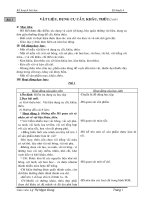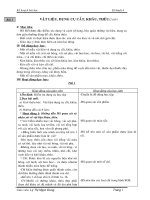Bài giảng MARKETING MANAGEMENT LECTURE NOTES: chap 4 analyze competitors
Bạn đang xem bản rút gọn của tài liệu. Xem và tải ngay bản đầy đủ của tài liệu tại đây (2.49 MB, 18 trang )
3/8/2018
Potential
competitors
Michael Porter’s
competitive five forces
Define the competitors
Threat of new
competitors
Power of
suppliers
Suppliers
Current
competitors
Analyze the competitors
Threat of
subtitution
Competition strategies
Prepared by: Huỳnh Hạnh Phúc
Customer
Power of
customer
Substitute
products
1
3/8/2018
Definition:
The process of identifying major
competitors, assessing their objectives,
strategies, strengths and weaknesses,
and selecting which competitors to
attack or avoid
1. Who the competitors are
2. What the competitors’ objectives are
3. What their strategies are
4. What their strengths and
weaknesses are
5. What their reaction patterns are
6. Who to confront and how to avoid
2
3/8/2018
Competitors could be
Brand competitors
Product competitors
DIRECT (within the same industry or market sector)
INDIRECT (competing for the consumer dollarsubstitutes)
LATENT (potential threats)
•
•
•
•
•
•
•
•
Same product
Same segmentation
Same price
Pepsi & Coca Cola, 7 Up & Sprite
Same product
Different segmentation
Different price
7 Up & Xá xị Chương Dương
Generic competitors
Total budget competitors
• Different product. Provide same
function. Eg. drink, transports, etc.
• It attempts to satisfy the same basic
customer need. Pepsi & sugar cane,
ice tea
- It would be any companies that have a
same costs
- Customer can spend 7000 VND (7up’s
price) for many different kind of
products
3
3/8/2018
BRAND COMPETITORS
PRODUCT COMPETITORS
GENERIC COMPETITORS
4
3/8/2018
TOTAL BUDGET COMPETITORS
Each competitor has a mix of objectives.
The company wants to know the relative importance
that a competitor places on current profitability,
market share growth, cash flow, technological
leadership, service leadership, and other goals.
Knowing a competitor’s mix of objectives reveals
whether the competitor is satisfied with its current
situation and how it might react to different
competitive actions.
more that one firm’s strategy
resembles another firm’s strategy, the
more the two firms compete.
A strategic group is a group of firms in
an industry following the same or a
similar strategy in a given target market
The
A company must also monitor its competitors’
objectives for various segments
5
3/8/2018
6
3/8/2018
Marketers need to assess each competitor’s strengths
and weaknesses carefully in order to answer the critical
question: What can our competitors do?
Development rate
Market share
As a first step, companies can gather data on each
competitor’s goals, strategies, and performance over the
last few years.
Companies normally learn about their competitors’
strengths and weaknesses through secondary data,
personal experience, and word of mouth.
R&D
Production
Profitability
Objectives
Strategy
HR
Customer’s perception
Target market
Marketing & brand
7
Product Segmentations
3/8/2018
Normal
toothpaste
Fluoride
toothpaste
Gel
toothpaste
ColgatePamolive
ColgatePamolive
ColgatePamolive
P&G, P/S
P&G, P/S,
Unilever
P&G,
Unilever
ColgatePamolive
ColgatePamolive
ColgatePamolive
P&G, P/S
P&G, P/S
P&G, P/S
ColgatePamolive
ColgatePamolive
ColgatePamolive
P&G,
P&G, Unilever
P&G,
Unilever
Kid
19-35 years old
From 36 years
old
What will our competitors do?
What are they looking
for?
A competitor’s objectives, strategies, and strengths and
weaknesses go a long way toward explaining its likely
actions. They also suggest its likely reactions to
company moves such as price cuts, promotion increases,
or new-product introductions.
Each competitor reacts differently.
What does it motivate
competitors?
Customer segmentation
8
3/8/2018
Biti’s
Strong or Weak Competitors: Most companies prefer to
compete against weak competitors. This requires fewer
resources and less time. But in the process, the firm may
gain little.
Close or Distant Competitors: Most companies will
compete with close competitors—those that resemble
them the most—rather than distant competitors.
“Good” or “Bad” Competitors: Good competitors play
by the rules of the industry. Bad competitors break the
rules. They try to buy share rather than earn it, take large
risks, and in general shake up the industry
Converse
Strategy
Marketing
R&D
HR
Finance
Customer’s
perception
9
3/8/2018
10
3/8/2018
11
3/8/2018
12
3/8/2018
13
3/8/2018
14
3/8/2018
15
3/8/2018
16
3/8/2018
17
3/8/2018
1. Read the content of chapter 5 and analyze
your company’s customer behavior
2.
and the factors that impact to the
customer behavior
Present the implication of the analysis
result (Customer insight)
18




